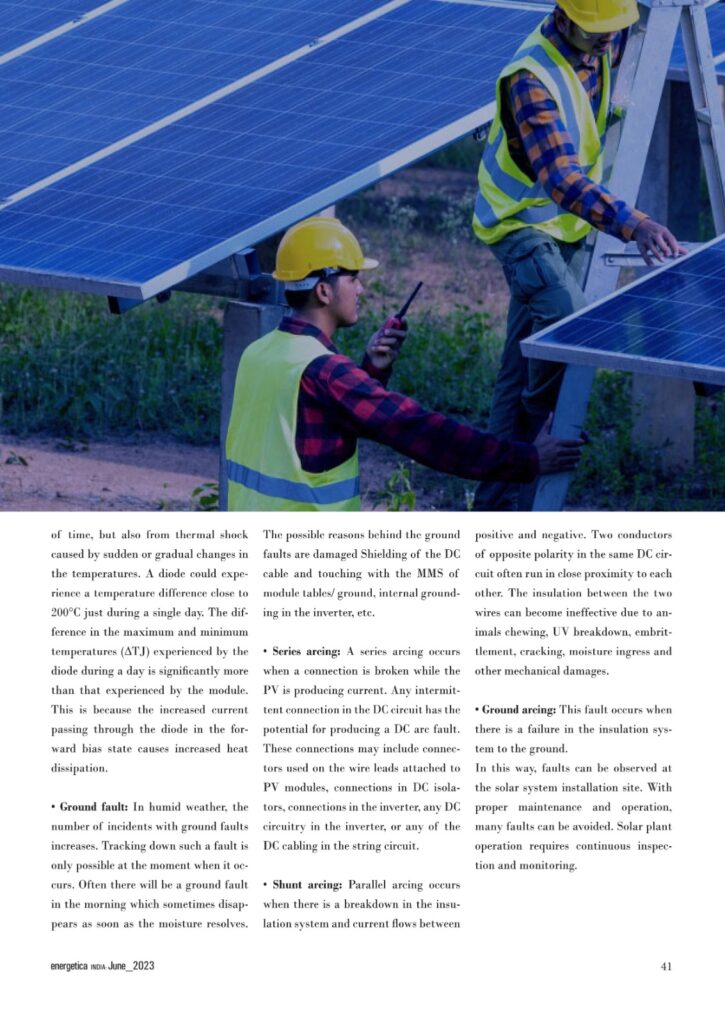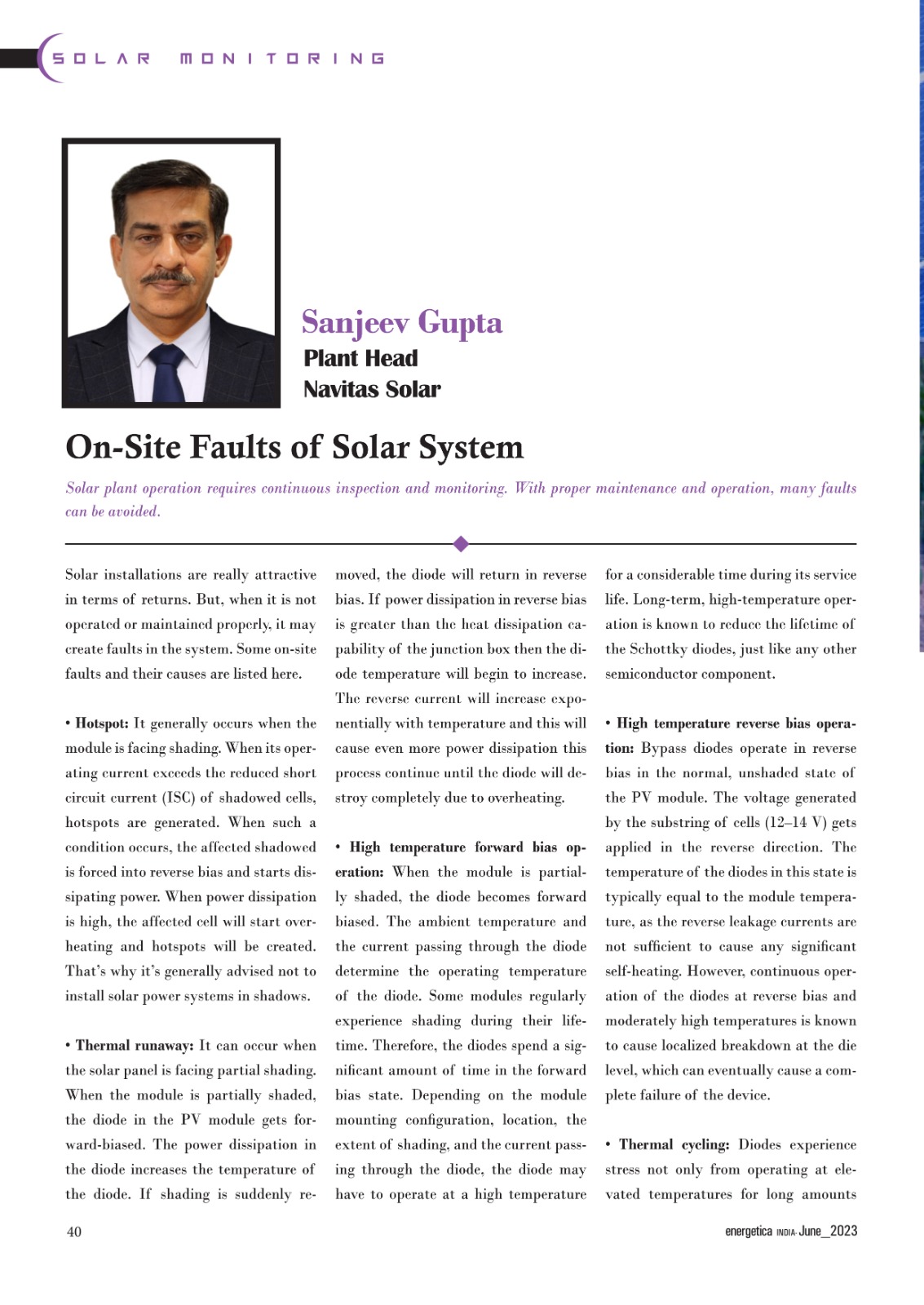Maximize Solar Power: Identifying & Fixing On-Site Faults

Solar installations are really attractive in terms of returns. But, when it is not operated or maintained properly, it may create faults in the system. Some on site faults and their causes are listed here.
Hotspot: It generally occurs when the module is facing shading. When its operating current exceed the reduced short circuit current (Isc) of shadowed cells, hotspots are generated. When such condition occurs, the affected shadowed is forced into reverse bias and start dissipating power. When power dissipation is high, the affected cell will start overheating and hotspots will be created. That’s why it’s generally advised not to install solar power system in shadows.
Thermal Runaway: It can occur when the solar panel is facing partial shading. When the module is partially shaded, the diode in PV module gets forward biased. The power dissipation in the diode increases the temperature of the diode. If shading is suddenly removed, the diode will return in reverse bias. If power dissipation in reverse bias is greater than the heat dissipation capability of junction box then the diode temperature will begin to increase. The reverse current will increase exponentially with temperature and this will cause even more power dissipation and this process continue until the diode will destroy completely due to overheating.
High temperature forward bias operation: When the module is partially shaded, the diode becomes forward biased. The ambient temperature and the current passing through the diode determine the operating temperature of the diode. Some modules regularly experience shading during their lifetime. Therefore, the diodes spend a significant amount of time in the forward bias state. Depending on the module mounting configuration, location, the extent of shading, and the current passing through the diode, the diode may have to operate at a high temperature for considerable time during its service life. Long-term, high-temperature operation is known to reduce the lifetime of the Schottky diodes, just like any other semiconductor components.
High temperature reverse bias operation: Bypass diodes operate in reverse bias in the normal, unshaded state of the PV module. The voltage generated by the substring of cells (12–14 V) gets applied in the reverse direction. The temperature of the diodes in this state is typically equal to the module temperature, as the reverse leakage currents are not sufficient to cause any significant self-heating. However, continuous operation of the diodes at reverse bias and moderately high temperatures is known to cause localized breakdown at the die level, which can eventually cause a complete failure of the device.
Thermal cycling: Diodes experience stress not only from operating at elevated temperatures for long amounts of time, but also from thermal shock caused by sudden or gradual changes in the temperatures. A diode could experience a temperature difference close to 200°C just during a single day. The difference in the maximum and minimum temperatures (ΔTJ) experienced by the diode during a day is significantly more than that experienced by the module. This is because the increased current passing through the diode in the forward bias state causing increased heat dissipation.
Ground Fault: In humid weather, the number of incidents with ground faults increase. Tracking down such a fault is only possible at the moment when it occurs. Often there will be a ground fault in the morning which sometimes disappears as soon as the moisture resolves. The possible reasons behind the ground faults are damaged Shielding of DC cable and touching with the MMS of module tables/ ground, internal grounding in inverter etc.
Series Arcing: A series arcing occurs when a connection is broken while the PV is producing current. Any intermittent connection in the DC circuit has the potential for producing a DC arc fault. These connections may include connectors used on the wire leads attached to PV modules, connections in DC isolators, connections in the inverter, any DC circuitry in the inverter or any of the DC cabling in the string circuit.
Shunt arcing: Parallel arcing occurs when there is a breakdown in the insulation system and current flows between positive and negative. Two conductors of opposite polarity in the same DC circuit are often run in close proximity to each other. The insulation between the two wires can become ineffective due to animals chewing, UV breakdown, embrittlement, cracking, moisture ingress and other mechanical damages.
Ground arcing: This fault occurs when there is a failure in insulation system to the ground.
In this way, faults can be observed at Solar system installation site. With proper maintenance and operation, many faults can be avoided. Solar plant operation requires continuous inspection and monitoring.


 Online | Privacy policy
Online | Privacy policy
Related Posts
You May Also Like
Bonito Series: Driving Innovation in…
Read MoreTOPCon Series: The Next Generation…
Read MoreValuable Points to Remember During…
Read MoreNavitas Planet Partners with Hysolwin…
Read MoreDriving Towards a Sustainable Future:…
Read MoreWhy Do Top-Grade EVA Sheets…
Read MoreBonito Series: Driving Innovation in…
Read MoreTOPCon Series: The Next Generation…
Read MoreValuable Points to Remember During…
Read MoreNavitas Planet Partners with Hysolwin…
Read MoreDriving Towards a Sustainable Future:…
Read MoreWhy Do Top-Grade EVA Sheets…
Read MoreBonito Series: Driving Innovation in…
Read MoreTOPCon Series: The Next Generation…
Read MoreValuable Points to Remember During…
Read MoreNavitas Planet Partners with Hysolwin…
Read More